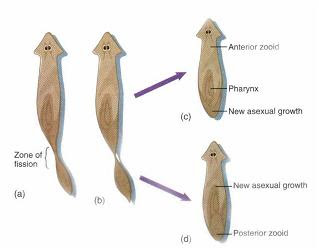Within the epidermal structures, there is also  a rod-shaped structure called Rhabdoids (circled green). Rhabdoids is used to produce mucus that prevents the flatworms from drying and protect it from predators.
a rod-shaped structure called Rhabdoids (circled green). Rhabdoids is used to produce mucus that prevents the flatworms from drying and protect it from predators.
Digestive Tract
 These flatworms from this class Turbellaria have an incomplete digestive tract, where the mouth leads to pharynx, then to blind intestines (enteron) or simply put, a temporary space that contain cells which ingest food particles by phagocytosis (engulfing the food). There are various types of pharynx, which is often used for classification. The pharynx ranges from simple to complex structures and shapes. For simple pharynx, the tubellarians feed on the food by simply sweeping the food particles and tiny prey by ciliary action. For the more complex pharynx, the tubellarians will fold its body around the prey and surround it with mucus after which the pharynx is everted over the prey. Most tubellarians would swallow their food by using their powerful pharyngeal muscles.
These flatworms from this class Turbellaria have an incomplete digestive tract, where the mouth leads to pharynx, then to blind intestines (enteron) or simply put, a temporary space that contain cells which ingest food particles by phagocytosis (engulfing the food). There are various types of pharynx, which is often used for classification. The pharynx ranges from simple to complex structures and shapes. For simple pharynx, the tubellarians feed on the food by simply sweeping the food particles and tiny prey by ciliary action. For the more complex pharynx, the tubellarians will fold its body around the prey and surround it with mucus after which the pharynx is everted over the prey. Most tubellarians would swallow their food by using their powerful pharyngeal muscles.
For the Turbellarian to move, it secretes mucus to provide lubrication as it moves along and serves as a medium against which cilia act. The turbellarians then glide along the slimy trails and the ciliated epidermis facilitate the locomotion. You can watch a video of the Turbellarian moving here Turbellarian Locomotion
Reproduction
There are two types of reproduction; asexual and sexual reproduction.
Asexual Reproduction
Asexual reproduction is common among the freshwater and terrestrial turbellarians such as triclads, Dugesia. They reproduce asexually by transverse fission (split into two) and have great regenerative capabilities. This means that if a part of their body is cut into half, they are able to grow the lost body part wit
hin a period of time.
You can view these video on the regeneration of planaria here Regeneration of Planaria .
Sexual Reproduction
Most Turbellarians are hermaphroditic, meaning that they contain the male and the female sex organs. However, they are unable to self-fertilize and thus need the sperm of other turbellarians to fertilize the egg. Now, let us take a look at the male and female systems of the Turbellarians.
The male part consists of single, paired or multiple testes, sperm ducts, seminal vesicle and penis.
Female System
For the female system, the Turbellarians may choose to either produce an entolecithal (both egg and yolk produced) or ectolecithal (only egg produced, yolk produced in yolk gland transported through vitelline duct) ova. Eventually, the eggs will move through an oviduct towards the female antrum.
So, during sexual reproduction, the penis will penetrate e caused by muscles contraction and insert into the female antrum, depositing the sperms there. Fertilization will then take place when the egg passes through the oviduct into the female antrum.





Youre so cool! I dont suppose Ive learn something like this before. So good to seek out someone with some unique ideas on this subject. realy thanks for beginning this up. this website is one thing that's wanted on the internet, someone with a bit originality. useful job for bringing one thing new to the internet! online casino games
ReplyDelete